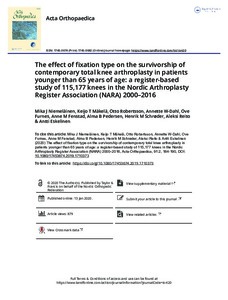| dc.contributor.author | Mika J. Niemeläinen | |
| dc.contributor.author | Alma B. Pedersen | |
| dc.contributor.author | Anne M. Fenstad | |
| dc.contributor.author | Otto Robertsson | |
| dc.contributor.author | Keijo T. Mäkelä | |
| dc.contributor.author | Ove Furnes | |
| dc.contributor.author | Henrik M. Schrøder | |
| dc.contributor.author | Antti Eskelinen | |
| dc.contributor.author | Annette W-Dahl | |
| dc.contributor.author | Aleksi Reito | |
| dc.date.accessioned | 2022-10-28T13:10:31Z | |
| dc.date.available | 2022-10-28T13:10:31Z | |
| dc.identifier.uri | https://www.utupub.fi/handle/10024/163331 | |
| dc.description.abstract | <div>Background and purpose - Cemented fixation is regarded as the gold standard in total knee arthroplasty (TKA). Among working-age patients, there has been controversy regarding the optimal fixation method in TKA. To address this issue, we conducted a register-based study to assess the survivorship of cemented, uncemented, hybrid, and inverse hybrid TKAs in patients aged < 65 years. <br /></div><div><br /></div><div>Patients and methods - We used the Nordic Arthroplasty Register Association data of 115,177 unconstrained TKAs performed for patients aged < 65 years with primary knee osteoarthritis over 2000-2016. Kaplan-Meier (KM) survival analysis with 95% confidence intervals (CI) and Cox multiple-regression model with adjustment for age, sex, and nation were used to compare fixation methods in relation to revision for any reason. <br /></div><div><br /></div><div>Results - The 10-year KM survivorship of cemented TKAs was 93.6% (95% CI 93.4-93.8), uncemented 91.2% (CI 90.1-92.2), hybrid 93.0% (Cl 92.2-93.8), and inverse hybrid 96.0% (CI 94.1-98.1). In the Cox model, hybrid TKA showed decreased risk of revision after 6 years' follow-up compared with the reference group (cemented) (hazard ratio [HR] 0.5 [CI 0.4-0.8]), while uncemented TKAs showed increased risk of revision both < 1 year (HR 1.4 [1.1-1.7]) and > 6 years' (HR 1.3 [1.0-1.7]) follow-up compared to the reference. <br /></div><div><br /></div><div>Interpretation - Both cemented and hybrid TKAs had 10-year survival rates exceeding 92->93% in patients aged < 65 years. Cemented TKA, however, was used in the vast majority (89%) of the operations in the current study. As it performs reliably in the hands of many, it still deserves the status of gold standard for TKA in working-age patients.</div> | |
| dc.language.iso | en | |
| dc.publisher | TAYLOR & FRANCIS LTD | |
| dc.title | The effect of fixation type on the survivorship of contemporary total knee arthroplasty in patients younger than 65 years of age: a register-based study of 115,177 knees in the Nordic Arthroplasty Register Association (NARA) 2000-2016 | |
| dc.identifier.urn | URN:NBN:fi-fe2021042821593 | |
| dc.relation.volume | 91 | |
| dc.contributor.organization | fi=tyks, vsshp|en=tyks, vsshp| | |
| dc.contributor.organization | fi=ortopedia ja traumatologia|en=Orthopaedics and Traumatology| | |
| dc.contributor.organization-code | 2607310 | |
| dc.converis.publication-id | 47400759 | |
| dc.converis.url | https://research.utu.fi/converis/portal/Publication/47400759 | |
| dc.format.pagerange | 190 | |
| dc.format.pagerange | 184 | |
| dc.identifier.jour-issn | 1745-3674 | |
| dc.okm.affiliatedauthor | Mäkelä, Keijo | |
| dc.okm.affiliatedauthor | Dataimport, tyks, vsshp | |
| dc.okm.discipline | 3126 Surgery, anesthesiology, intensive care, radiology | en_GB |
| dc.okm.discipline | 3126 Kirurgia, anestesiologia, tehohoito, radiologia | fi_FI |
| dc.okm.internationalcopublication | international co-publication | |
| dc.okm.internationality | International publication | |
| dc.okm.type | Journal article | |
| dc.publisher.country | Britannia | fi_FI |
| dc.publisher.country | United Kingdom | en_GB |
| dc.publisher.country-code | GB | |
| dc.relation.doi | 10.1080/17453674.2019.1710373 | |
| dc.relation.ispartofjournal | Acta Orthopaedica | |
| dc.relation.issue | 2 | |
| dc.year.issued | 2020 | |
